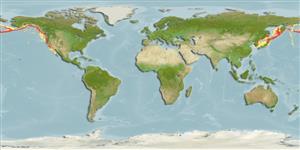Environment: milieu / climate zone / depth range / distribution range
Écologie
marin bathydémersal; profondeur 50 - 2453 m (Ref. 123358), usually 500 - 700 m (Ref. 56456). Deep-water
North Pacific: Bering Sea to off San Diego in California, USA.
Taille / Poids / Âge
Maturity: Lm ? range ? - ? cm
Max length : 54.0 cm TL mâle / non sexé; (Ref. 80637); common length : 36.0 cm TL mâle / non sexé; (Ref. 56456); poids max. publié: 1.7 kg (Ref. 56456); âge max. reporté: 8 années (Ref. 56456)
Description synthétique
Clés d'identification | Morphologie | Morphométrie
Épines dorsales (Total) : 0; Rayons mous dorsaux (Total) : 54 - 58; Épines anales: 0; Rayons mous anaux: 37 - 50. Dorsal fin extending about halfway along length of caudal fin; caudal narrow, slightly rounded; lower 6 rays of pectorals slightly thickened and completely exserted, the next 5 greatly to moderately exserted and longer than the rays immediately above them, no real notch in fin; pelvic fins modified to form a small adhesive disc with a thickened margin, placed far forward, below eye (Ref. 6885). Off-white to pale rose on body; ends of pectoral and edges of posterior parts of dorsal and anal, and most of the caudal, black; lining of mouth and gill cavity, and tongue black (Ref. 6885).
Found on mud bottoms (Ref. 2850). Possibly the most commonly captured liparid below 200 m; captured frequently by fishers (Ref. 26773). Known to feed on polychaete worms, small crustaceans, tiny clams and other invertebrates (Ref. 4525).
Life cycle and mating behavior
Maturité | Reproduction | Frai | Œufs | Fécondité | Larves
Eschmeyer, W.N., E.S. Herald and H. Hammann, 1983. A field guide to Pacific coast fishes of North America. Boston (MA, USA): Houghton Mifflin Company. xii+336 p. (Ref. 2850)
Statut dans la liste rouge de l'IUCN (Ref. 130435: Version 2024-1)
Menace pour l'homme
Harmless
Utilisations par l'homme
Pêcheries: sans intérêt
Outils
Articles particuliers
Télécharger en XML
Sources Internet
Estimates based on models
Preferred temperature (Ref.
123201): 0.4 - 5.2, mean 3.2 °C (based on 67 cells).
Phylogenetic diversity index (Ref.
82804): PD
50 = 0.5000 [Uniqueness, from 0.5 = low to 2.0 = high].
Bayesian length-weight: a=0.00468 (0.00278 - 0.00786), b=3.23 (3.08 - 3.38), in cm total length, based on LWR estimates for this species & Genus-body shape (Ref.
93245).
Niveau trophique (Ref.
69278): 3.4 ±0.47 se; based on food items.
Résilience (Ref.
120179): Milieu, temps minimum de doublement de population : 1,4 à 4,4 années (Assuming tmax>3).
Fishing Vulnerability (Ref.
59153): Moderate vulnerability (42 of 100).
